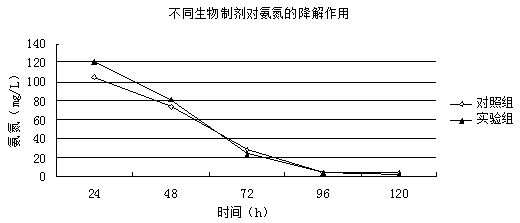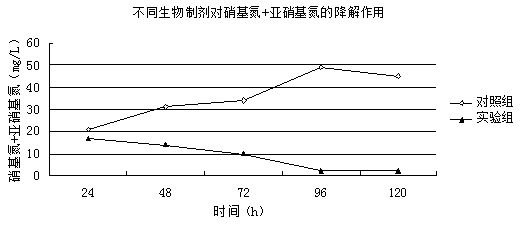Environmentally-friendly technology for treating xanthan gum fermentation wastewater
A technology for fermenting wastewater and xanthan gum, which is applied in the direction of filtration treatment, precipitation treatment, special treatment goals, etc., can solve the problems of difficult cultivation operation process, inability to completely degrade ammonia nitrogen, and reduce sludge production, so as to achieve simple process and avoid excessive Proliferation and volume reduction effects
- Summary
- Abstract
- Description
- Claims
- Application Information
AI Technical Summary
Problems solved by technology
Method used
Image
Examples
Embodiment 1
[0032] The biological preparation for the treatment of xanthan gum fermentation process wastewater is prepared according to the following process:
[0033] The kaolin and bentonite were mixed in a mass ratio of 2:1, and then added to a ball mill equipped with a ball milling medium (5mm silicon carbide balls, mass ratio of material to balls 1:5) for ball milling for 30 minutes, dried at 80 ° C for 15 minutes, and then passed for 100 minutes. Mesh sieve, collect the undersize;
[0034] Mix polyvinyl alcohol, attapulgite, urea, water and undersize in a mass ratio of 3:5:7:70:100, then put into a granulator for granulation to obtain wet granules with a diameter of 1 mm , and then dried at 80°C for 30min, then placed in a resistance furnace for calcination at 1000°C for 30min, and after natural cooling, ceramsite was obtained;
[0035] Mix bacterial agent A and ceramsite according to the ratio of 1L: 2kg, and culture at 30°C for 6h.
[0036]Then add bacterial agent B and 40g / L so...
Embodiment 2
[0041] The biological preparation for the treatment of xanthan gum fermentation process wastewater is prepared according to the following process:
[0042] The kaolin and bentonite were mixed in a mass ratio of 2:1, and then added to a ball mill equipped with a ball milling medium (5mm silicon carbide balls, mass ratio of material to balls 1:5) for ball milling for 30 minutes, dried at 80 ° C for 15 minutes, and then passed for 100 minutes. Mesh sieve, collect the undersize;
[0043] Mix the polyvinyl alcohol, attapulgite, urea, water and undersize in a mass ratio of 3:5:7:70:100, and then put it into a granulator for granulation to obtain wet granules with a diameter of 2 mm. , and then dried at 80°C for 30min, then placed in a resistance furnace for calcination at 1000°C for 40min, and after natural cooling, ceramsite was obtained;
[0044] Mix bacterial agent A and ceramsite according to the ratio of 1L: 2kg, and culture at 30°C for 6h.
[0045] Then add bacterial agent B...
Embodiment 3
[0051] The index detection of the ceramsite of the present invention.
[0052] Porosity: use the boiling method of GB / T1966-1996 to determine the porosity of the sample;
[0053] Mechanical strength: measured by GBT1965 / 1996 test method for flexural strength of porous ceramics.
[0054] The specific indicators are shown in Table 1:
[0055] Table 1
[0056] group Porosity % Mechanical strength Mpa Density g / ml Example 1 72.8 14.6 1.04 Example 2 70.6 15.3 1.08
[0057] It can be seen that the porosity of the ceramsite carrier of the present invention reaches more than 70%, the pore diameter is between 0.1-10 microns, it is easy to process, the strength is high, the porosity is high, the density is close to that of water, it is in a suspended state, and the dispersibility in waste water is good. , which is conducive to the rapid adsorption and treatment of pollutants.
PUM
| Property | Measurement | Unit |
|---|---|---|
| Aperture | aaaaa | aaaaa |
Abstract
Description
Claims
Application Information
 Login to View More
Login to View More - R&D
- Intellectual Property
- Life Sciences
- Materials
- Tech Scout
- Unparalleled Data Quality
- Higher Quality Content
- 60% Fewer Hallucinations
Browse by: Latest US Patents, China's latest patents, Technical Efficacy Thesaurus, Application Domain, Technology Topic, Popular Technical Reports.
© 2025 PatSnap. All rights reserved.Legal|Privacy policy|Modern Slavery Act Transparency Statement|Sitemap|About US| Contact US: help@patsnap.com


